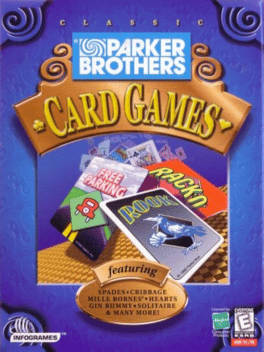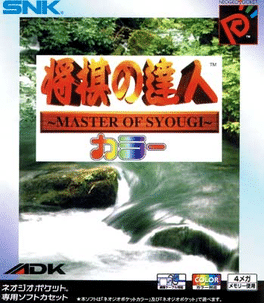New Gamegear Games - Page 55
-
Dragon Money
1999
Dragon Money
1999
Dragon Money is a board game up to 4 players in which the player can choose 1 of 6 different characters and play the board. -
Logic Mahjong Souryu: Yon-nin Uchi / San-nin Uchi
1999
Here's a traditional mahjong game with no cheaters. In addition to the typical four-person rules, you can play a speedier game of three-player mahjong, with bigger chances of bigger hands. You can change various rules, and even experience an adventure-game-like story mode. There's even a hidden mode where you can play a match against characters from the "Marl Kingdom" series of games. Casual controls and traditional gameplay--this game is enjoyable for all ages. -
Culdcept Expansion
1999
Culdcept Expansion
1999
The initial 1999 PlayStation release, Culdcept Expansion, has an additional four maps for a total of 14, and also contains 360 cards but 10 of them have been replaced with new ones for balance reasons, as well as the ability to load custom maps from a memory card. Your objective is to have collect enough magic points (MP) before your opponents do and reach the castle. You do this by controlling areas on the board with creatures that you summon. Players (called Cepters) affect each other by attacking each other's creatures with their own. Players cannot directly attack each other, but can cast spells on each other. If you lose a battle on an opponent's square, you must pay them (rent) as MPs. -
Simple 1500 Series: Vol.9 - The Chess
1999
Simple 1500 Series: Vol.9 - The Chess is a chess game that features a single mode, a 2 players vs mode & a tutorial explaining the rules of chess. Chess is a two-player board game played on a chessboard, a square-checkered board with 64 squares arranged in an eight-by-eight grid. Each player begins the game with sixteen pieces: One king, one queen, two rooks, two knights, two bishops, and eight pawns. Pieces move in different assigned ways according to their type, and accordingly are used to attack and capture the opponent's pieces. The object of the game is to checkmate the opponent's king, whereby the king is under immediate attack (in "check") and there is no way to move or defend it. -
Check Mate
1999
Check Mate
1999
Dozens of different options and visual guides make Check Mate the perfect way to improve your game. Choose from a range of difficulty settings as you attempt to beat the computer, or checkmate a friend in the two-player mode. -
Mahjong: Touryuumon
1999
Mahjong: Touryuumon
1999
Mahjong Touryuumon is a Miscellaneous game, developed by Chat Noir and published by Sammy Studios, which was released in Japan in 1999. -
0 kara no Shougi: Shougi Youchien - Ayumi-gumi
1999
This is a shogi game that features 5 different kind of boards, a complete tutorial and a dictionary in Japanese language, different vs modes (also a 2 player vs mode), a sort of a battle mode in which the player advance defeating opponents and the game has 10 different opponents. -
Nihon Pro Mahjong Renmei Kounin: Tehodoki Mahjong Nyuumon-hen
1999
Nihon Pro Mahjong Renmei Kounin - Tehodoki Mahjong Nyuumon-hen is a educational game in which the player will learn the different rules of mahjong. The game will use video tutorial and quiz tests to teach the player evaluate his understanding. Mahjong is a game for four players that originated in China. Mahjong involves skill, strategy, and calculation, as well as a certain degree of chance. Depending on the variation which is played, luck can be anything from a minor to a dominant factor in success. In Asia, mahjong is also popularly played as a gambling game. In the game, each player is dealt either thirteen or sixteen tiles in a hand (depending on the variation being played). On their turn, players draw a tile and discard one, with the goal of making four or five melds (also depending on the variation) and one pair, or "head". Winning comes "on the draw", by drawing a new or discarded tile that completes the hand. Thus a winning hand actually contains fourteen (or seventeen) tiles. -
Parker Brothers: Card Games
1999
Parker Brothers: Card Games is a collection of card games licensed by Parker Brothers. The player can create a profile and go head-to-head with animated computer-controlled characters in one of nine classic card games: - Free Parking - Millie Bornes - Cribbage - Gin Rummy - Hearts - Racko - Rook - Solitaire - Spades Although the servers have long since been shut down, it was also possible to play a game online on Microsoft's Zone.com online gaming service (now MSN Games). -
Othello! Japan
1999
-
Abalone
1999
Abalone
1999
An unofficial adaptation of the board game made by French amateur developer Olivier Thill -
Master of Syougi Color
1999
Master of Syougi Color is a Japanese style chess game. In single player mode the player must compete against computerized opponents (represented by a digitized photograph) to win the tournament. In two player mode, each player competes against each another. -
Caesar's Palace VIP Series: BlackJack
1998
Caesars Palace VIP Series Blackjack is a 1998 "gambling simulation" published by Interplay, focused on Blackjack card game variants. -
Candy Land: A Child's First Game Comes to Life
1998
The Candy Land computer game is a version of the classic board game brought to life and enhanced. One player can play against a computer opponent, or up to 4 people can take turns. To advance, a player clicks on a machine which produces a piece of colored candy. The player is allowed to move to the next space that shares the same color as the candy which was just drawn. Some spaces are sticky and if a player lands on one, they will lose one or more turns. Some pieces contain special candies which will cause a player to warp to different areas on the board, which may be either ahead or behind of the player's current space. In addition to playing the classic board game, this game offers the player side trips to explore 8 different areas, each with fun activities: Gingerbread Plum Trees: Help Plumpy (the last of the Plumpa trolls) collect plums for pies. Do this by clicking on him to tickle him so he'll surrender a plum. Licorice Castle: Lord Licorice has a telescope mounted atop his castle through which y -
31
1998
-
Taisen Hot Gimmick Kairakuten
1998
The second game in the Taisen Hot Gimmick series, with art based on Japanese men's magazine Kairakuten.



















